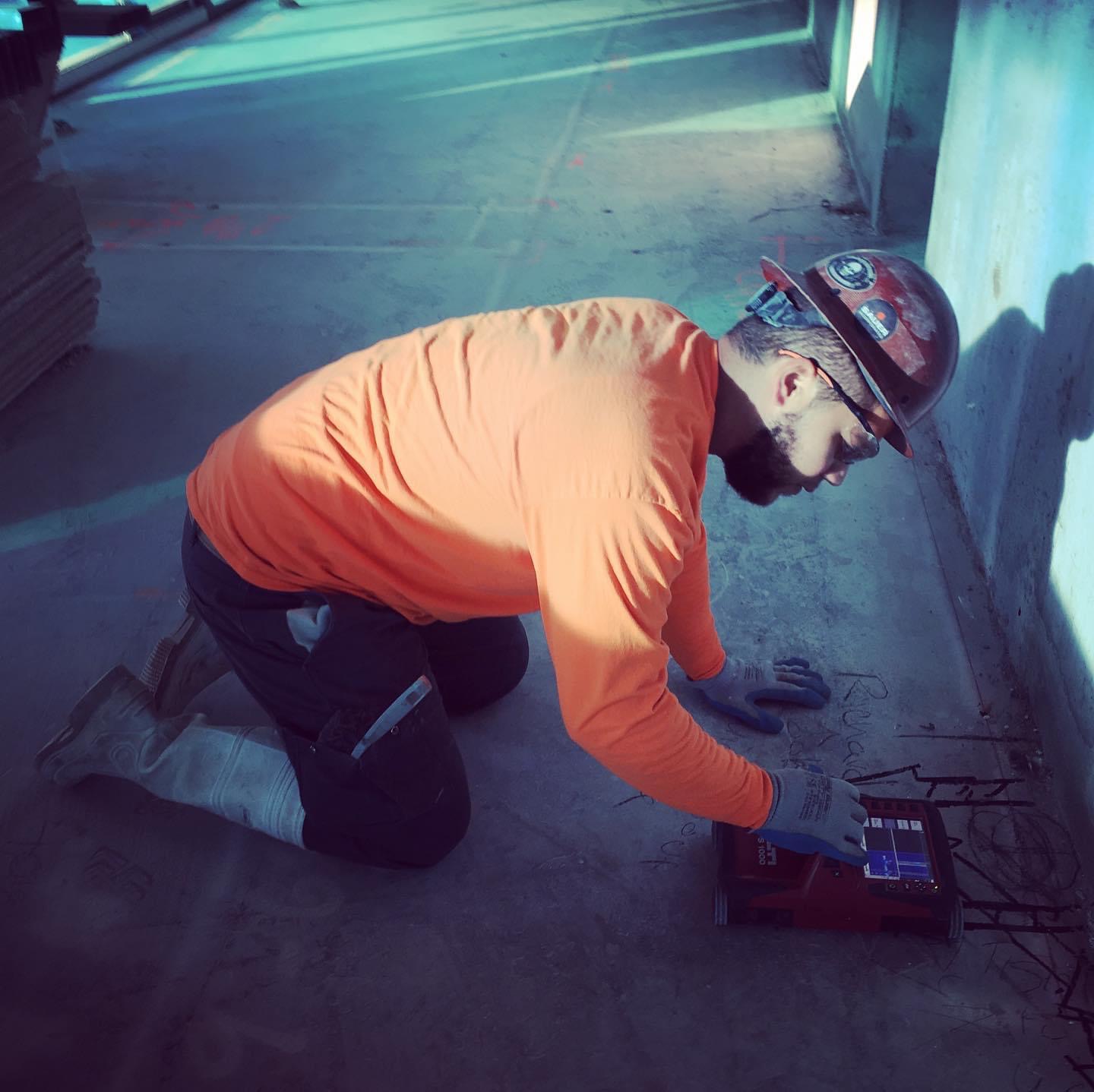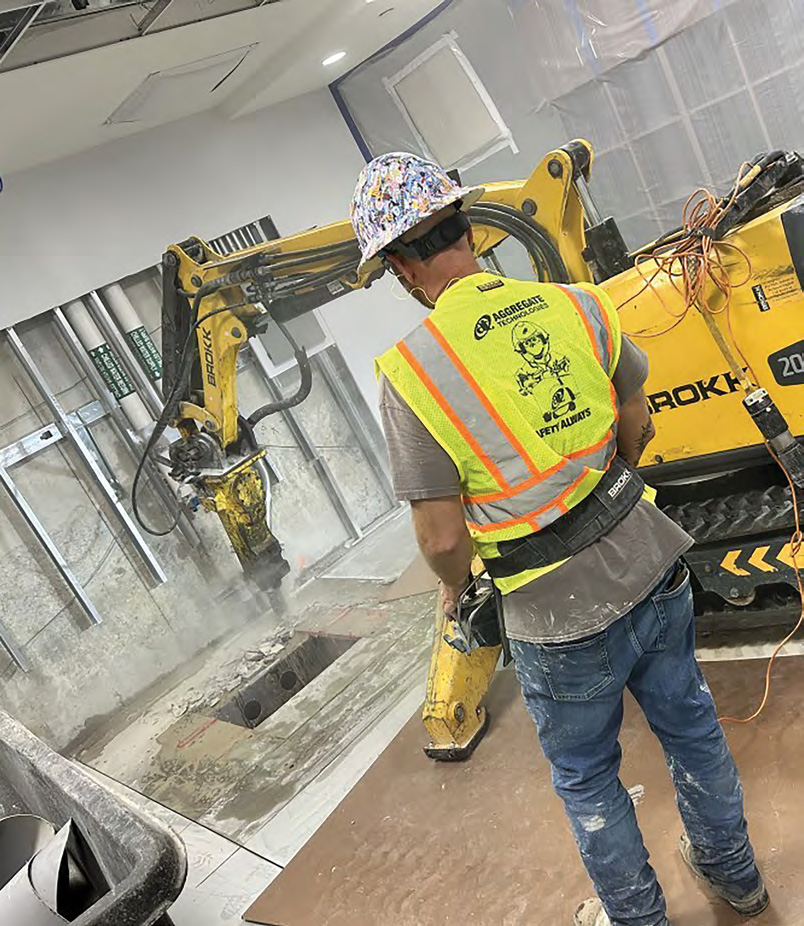
Chicago Riverwalk Expansion

Out-of-the-Box Creativity Gets the Job Done
(Header photo courtesy of Roman Arkhipov)
A professional concrete sawing and drilling contractor employed a custom-engineered saw system to complete over 600 linear feet of challenging horizontal cuts on the City of Chicago’s high-profile Riverwalk project. This specialty cutter was tasked with cutting and removing a stretch of damaged curb measuring 10 inches wide and just 5 inches tall completely flush with the rest of the deck surface.
The Chicago Riverwalk is located on the south bank of the Chicago River in the downtown area of the city. Spanning 1.2 miles from Lake Shore Drive to Lake Street, the project was originally developed in the 1990s as an initiative to reclaim this stretch of the river for the ecological, recreational and economic benefit of the city.
As part of two new phases of expansion work on the initiative, general contractor Walsh Construction needed to complete the construction of a new pedestrian ramp to connect the upper and lower levels of the Riverwalk close to Wabash Avenue. The old damaged concrete curb was removed so that a new one could be poured. An Internet search led the general contractor to a solution provided by an Indiana-based CSDA member, and the cutting contractor was subsequently selected to do the work. However, even this specialty diamond cutter knew the job was no easy task.
“The concrete was heavily reinforced with steel rebar,” said John Baaske, owner of CSDA member Northwest Indiana Concrete Cutting in Schererville, Indiana. “What made things worse was that some of this rebar was positioned horizontally at the exact elevation of the flush cuts. Therefore, roughly 60% of the work involved cutting through the lengths of the rebar rather than through the diameters.”

A custom-made concrete sawing attachment allowed the contractor to perform flush cutting techniques on the Chicago Riverwalk.
Sawing through so much steel is not uncommon for contractors like Baaske, but this particular flush cutting task was made even more challenging because the height of the curb was not tall enough to attach any track-mounted equipment. With 600 linear feet of reinforced concrete to cut, attempting to do the work with a hand saw was not feasible either. Therefore, Northwest Indiana Concrete Cutting had to come up with a way to cut the specified length of the 10-inch-thick, 5-inch-tall Chicago Riverwalk curb with the accuracy and efficiency of a track-mounted unit, but without anything to attach it to.
Challenging situations like this in the past had led Baaske to invent and fabricate the All Terrain Concrete Saw attachment, which is now manufactured and sold by JS Innovations. The 700-pound, hydraulic-powered attachment was designed to fit on the company’s 25-horsepower skid steer, providing a stable yet maneuverable piece of equipment to create the flush cuts without having to mount a saw. It was also made with an articulating head, meaning the contractor could flip it 180 degrees to perform flush cuts on the inside or outside of curbs. The saw’s 5,000 psi motor could easily accommodate a 28-inch-diameter blade, supplied by Husqvarna Construction Products, to make the 10-inch-deep cuts.
Additionally, the attachment was small enough to be lifted onto the pedestrian ramp, as there was no final connection from the upper sidewalk to the ramp. Neither was there a connection from the other end of the ramp to the lower level below. It was essentially a freestanding structure at the time the cutting work was completed. Aside from the tricky access, the width of the ramp was only 8 feet so the contractor needed to work in a small footprint with a five-day schedule set by the general contractor.

A 600-linear-foot stretch of reinforced concrete curb was damaged and had to be removed.
Northwest Indiana Concrete Cutting mobilized and began setting up the work area on the Chicago Riverwalk. The All Terrain Concrete Saw attachment and skid steer were lowered onto the pedestrian ramp deck separately by crane before the operator was transported there too. Prior to this, the general contractor erected temporary construction railings on the ramp to prevent falls. With both pieces of equipment positioned in the work area and the diamond blade mounted on the saw, the attachment and skid steer were connected and the contractor was making cuts within 10 minutes.
Saw cutting started at the upper end of the ramp and moved from west to east as the contractor worked down to the lower level. The operator of the cutting machine had to perform approximately 50 linear feet of radial flush cutting in line with the curvature of the ramp, while the remaining 550 feet was straight. To allow for wet cutting, water was pumped from the Chicago River and through the attachment to the cut, but Baaske’s machine was also designed to draw water from tanks mounted on the skid steer. After completing two to three linear feet of curb cutting, a sledgehammer was used to break off the cut pieces and all concrete was removed from the jobsite by Walsh Construction.

Curb sections were cut and broken off at approximately 3-foot intervals.
Over five shifts, the concrete sawing operator used the custom-fabricated saw system to cut 600 linear feet of reinforced concrete curb flush to the surface of the existing ramp, leaving a clean, smooth surface for the general contractor to pour the new curb. The operator used the saw to follow tight to the curved portions of the curb with interrupting cutting progress. Once completed, the attachment and host machine were detached from each other and lifted by crane back to street level so they could be placed on the contractor’s work trucks. Baaske was pleased with how the saw performed.
“I was extremely satisfied with the saw attachment. The placement of the rebar in the curb was an extra challenge, but the saw handled it well. This was the only machine I felt could do the job at the production level that was needed. A hand saw would not have had the capacity or production output required to cut the specified length of the 10-inch-wide and 5-inch-tall curb. Plus we had no easy way to position ourselves on the outside of the curb to complete the cuts from that angle.”
Baaske continued, “The time taken to break down the attachment and skid steer, move the equipment to the jobsite and reassemble on the ramp was around 30 minutes. We were spinning blades and cutting immediately after. The All Terrain Concrete Saw can cut anywhere from -5 degrees to 90 degrees, and as high as its host machine can reach. Through further development with JS Innovations, we have also used it on projects were we have spun a 42-inch-diameter blade.”
Phases two and three of the Chicago Riverwalk expansion, which included the work done by Northwest Indiana Concrete Cutting and the All Terrain Concrete Saw attachment, were completed and opened in October 2016. The Riverwalk now spans over nine blocks along the Chicago River and is enjoyed by thousands of city residents and tourists each day.
Chicago Riverwalk Expansion
Once a meandering marshy stream, the Chicago River first became an engineered channel to support the industrial transformation of the city. Following the famed reversal of the river, in which the city reversed the flow of the Main Branch and South Branch to improve sanitation, architect and urban planner Daniel Burnham introduced a new civic vision of riverside promenades with the addition of the Wacker Drive viaduct. This vision gave birth to the Chicago Riverwalk project. In 2012, a team of architectural and engineering firms, supported by technical consultants, was tasked with completing the vision for phases two and three: six blocks between State Street and Lake Street. Building off the previous studies of the river, the team’s plans provided a pedestrian connection along the river between the lake and the river’s confluence.
The task at hand was technically challenging. The design team needed to work within a tight permit-mandated 25-foot-wide build-out area to expand the pedestrian program spaces and negotiate a series of under-bridge connections between blocks. Further, the design had to account for the river’s annual flood dynamics of nearly seven vertical feet. Now, with new connections that enrich and diversify life along the river, each block takes on the form and program of a different river-based typology. These spaces include:
The Marina Plaza: Restaurants and outdoor seating provide views of vibrant life on the water, including passing barges, patrols, water taxis, and sightseeing boats.
The Cove: Kayak rentals and docking for human-powered crafts provide physical connections to the water through recreation.
The River Theater: A sculptural staircase linking Upper Wacker and the Riverwalk offers pedestrian connectivity to the water’s edge and seating, while trees provide greenery and shade.
The Water Plaza: A water feature offers an opportunity for children and families to engage with water at the river’s edge.
The Jetty: A series of piers and floating wetland gardens offers an interactive learning environment about the ecology of the river, including opportunities for fishing and identifying native plants.
The Boardwalk: An accessible walkway and new marine edge creates continuous access to Lake Street and sets the scene for future development in this critical space at the confluence.
For more information, visit www.chicagoriverwalk.us/riverwalk-expansion.
Company Profile
Northwest Indiana Concrete Cutting has been in business for nine years and became a CSDA member in 2016. The company is based in Schererville, Indiana and services the entire Midwest. Northwest Indians Concrete Cutting offers the services of slab sawing, core drilling, wall sawing, curb cutting, egress window installation, and specialty services provided by JS Innovations’ All Terrain Concrete Saw attachment.
Resources
General Contractor:
Walsh Construction
Sawing and Drilling Contractor:
Northwest Indiana Concrete Cutting.
Schererville, Indiana
Phone: 219-865-0008
Email: icscompanies@aol.com
Website: www.northwestindianaconcretecutting.com
Methods Used: Wall Sawing














